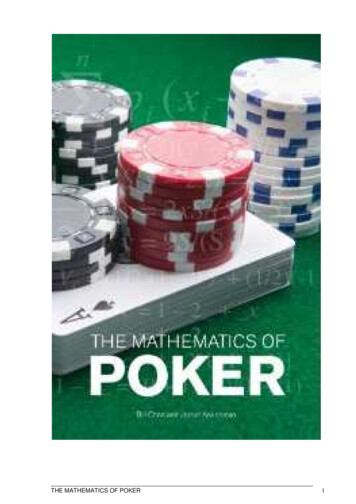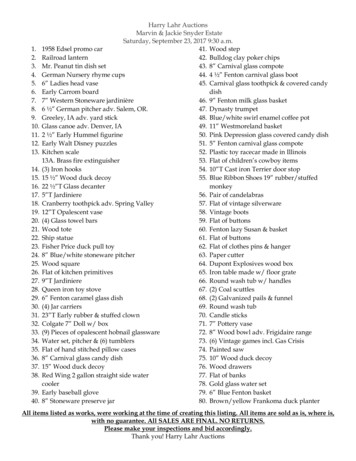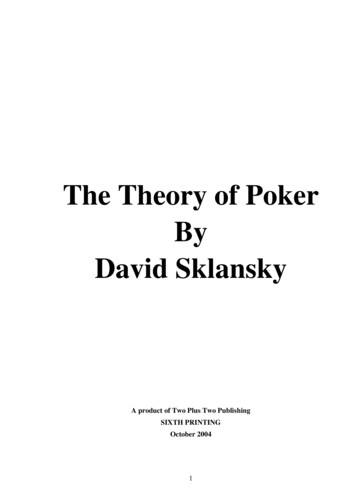
Transcription
THE MATHEMATICS OF POKER1
Other ConJelCo titles:Cooke's Rules of Real Poker by Roy Cooke and John BondHold'em Excellence by Lou KriegerHow to Play Like a Poker Pro by Roy Cooke and John BondHow to Think Like a Poker Pro by Roy Cooke and John BondInternet Poker by Lou Krieger and Kathleen WattersonMastering No-Limit Hold'em by Russ Fox and Scott T. HarkerMore Hold'em Excellence by Lou KriegerReal Poker II: The Play of Hands J 992-1999 (2nd ed.)by Roy Cooke and John BondSerious Poker by Dan KimbergStepping Up by Randy BurgessThe Home Poker Handbook by Roy Cooke and John BondWhy You Lose at Poker by Russ Fox and Scott T. HarkerWinning Low-Limit Hold'em by Lee JonesWinning Omaha/8 Poker by Mark Tenner and Lou KriegerWinning Strategies for No-Limit Hold'emby Nick Christenson and Russ FoxVideo Poker – Optimum Play by Dan PaymarSoftwareStatKing for WindowsTHE MATHEMATICS OF POKER2
The Mathematics of PokerCopyright 2006 by Bill Chen and Jerrod AnkenmanAll rights reserved. This book may not be duplicated in any way or stored m an informationretrieval system, without the express written consent of the publisher, except in the form of briefexcerpts or quotations for the purpose of review. Making copies of this book, or any portion, forany purpose other than your own. is a violation of United States copyright laws.Publisher's Cataloging-in-Publication DataChen, BillAnkenman, JerrodThe Mathematics of Pokerx,382p. ; 29cm.ISBN-13: 978-1-886070-25-7ISBN-10:1-886070-25-3I Title.Library of Congress Control Number: 2006924665First Edition57986Cover design by Cat ZaccardiBook design by Daniel PipitoneDigital production by Melissa NeelyConJeiCo LLC1460 Bennington AvePittsburgh, PA 15217[412] 621-6040http://www.conjelco.comErrata, if any, can be found at http://www.conjelco.com/mathofpoker/THE MATHEMATICS OF POKER3
Acknowledgments Foreword .Introduction 568Part I: BasicsDecisions Under Risk: Probability and Expectation Chapter 1Predicting the Future: Variance and Sample Outcomes .Chapter 2Using All the Information: Estimating Parameters and Bayes' Theorem Chapter 3152434Part II: Exploitive PlayPlaying the Odds: Pot Odds and Implied Odds Chapter 4Scientific Tarot: Reading Hands and Strategies Chapter 5The Tells are in the Data: Topics in Online Poker .Chapter 6Playing Accurately, Part I: Cards Exposed Situations .Chapter 7Playing Accurately, Part II: Hand vs. Distribution .Chapter 8Adaptive Play: Distribution vs. Distribution Chapter 9475970748594Part III: Optimal PlayChapter 10 Facing The Nemesis: Game Theory .Chapter 11 One Side of the Street: Half-Street Games .Chapter 12 Headsup With High Blinds: The Jam-or-Fold Game Chapter 13 Poker Made Simple: The AKQ Game .Chapter 14 You Don't Have To Guess: No-Limit Bet Sizing .Chapter 15 Player X Strikes Back: Full-Street Games .Appendix to Chapter 15 The No-Limit AKQ Game Chapter 16 Small Bets, Big Pots: No-Fold [0,1] Games Appendix to Chapter 16 Solving the Difference Equations .Chapter 17 Mixing in Bluffs: Finite Pot [0,1] Games Chapter 18 Lessons and Values: The [0,1]Game Redux .Chapter 19 The Road to Poker: Static Multi-Street Games .Chapter 20 Drawing Out: Non-Static Multi-Street Games .Chapter 21 A Case Study: Using Game Theory .100110121138146155167174191194212228243259Part IV: RiskChapter 22Chapter 23Chapter 24Chapter 25Staying in Action: Risk of Ruin Adding Uncertainty: Risk of Ruin with Uncertain Win Rates .Growing Bankrolls: The Kelly Criterion and Rational Game Selection .Poker Finance: Portfolio Theory and Backing Agreements .274288297303Part V: Other topicsChapter 26 Doubling Up: Tournaments, Part I Chapter 27 Chips Aren't Cash: Tournaments, Part II .Chapter 28 Poker's Still Poker: Tournaments, Part III Chapter 29 Three's a Crowd: Multiplayer Games .Chapter 30 Putting It All Together: Using Math to Improve Play .312324338349359Recommended Reading . 365About the Authors . 366About the Publisher . 367THE MATHEMATICS OF POKER4
AcknowledgmentsA book like this is rarely the work of simply the authors; many people have assisted us along theway, both in understanding poker and in the specific task of writing down many of the ideas thatwc have developed over the last few years. A book called The Mathematics of' Poker wasconceived by Bill, Chuck Weinstock, and Andrew Latto several years ago, before Jerrod and Billhad even met. That book was set to be a fairly formal, textbook-like approach to discussing themathematical aspects of the game. A few years later, Jerrod and Bill had begun to collaborate onsolving some poker games and the idea resurfaced as a book that was less like a mathematicspaper and more accessible to readers with a modest mathematical background.Our deepest thanks to those who read the manuscript and provided valuable feedback. Mostnotable among those were Andrew Bloch, Andrew Prock, and Andrew Latto, who scouredsections in detail, providing criticisms and suggestions for improvement. Andrew Prock'sPokerStove tool (http://www.pokerstove.com) was quite valuable in performing many of theequity calculations. Others who read the manuscript and provided useful feedback were Paul R.Pudaite and Michael Maurer.Jeff Yass at Susquehanna International Group (http://www.sig.com) has been such a generousemployer in allowing Bill to work on poker, play the World Series, and so on. We thank DougCosta, Dan Loeb,Jay Siplestien, and Alexei Dvoretskii at SIG for their helpful comments.We have learned a great deal from a myriad of conversations with various people in the pokercommunity. Our friend and partner Matt Hawrilenko, and former WSOP champion ChrisFerguson are two individuals especially worth singling out for their insight and knowledge. Bothof us participate enthusiastically in the *ARG community, and discussions with members of thatcommunity, too, have been enlightening, particularly round table discussions with playersincluding Sabyl Cohen, Jack Mahalingam, JP Massar, Path Beadles, Steve Landrum. and (1999Tournament of Champions winner) Spencer Sun.Sarah Jennings, our editor, improved the book significantly in a short period of rime by beingwilling to slog through equations and complain about the altogether too frequent skipped steps.Chuck Weinstock at Conjelco has been amazingly patient with all the delays and extendeddeadlines that come from working with authors for whom writing is a secondary occupation.We also appreciate the comments and encouragement from Bill's father Dr. An-Ban Chen whohas written his own book and has numerous publications in his field of solid state physics.Jerrod's mother Judy has been a constant source of support for all endeavors, even crazysounding ones like playing poker for a living.Throughout the writing of this book, as in the rest of life, Michelle Lancaster has constantly beenwonderful and supportive of Jerrod. This book could not have been completed without her.Patricia Walters has also provided Bill with support and ample encouragement, and it is of nocoincidence that the book was completed during the three years she has known Bill.THE MATHEMATICS OF POKER5
ForewordDon’t believe a word I say.It’s not that I'm lying when I tell you that this is an important book. I don't even lie at the pokertable -- not much, anyway - so why would I lie about a book I didn't even write?It’s just that you can't trust me to be objective. I liked this book before I'd even seen a singlepage. I liked it when it was just a series of conversations between Bill, myself, and a handful ofother math geeks. And if I hadn't made up my mind before I'd read it, I'm pretty sure they’d havewon me over with the first sentence.Don’t worry, though. You don't have to trust me. Math doesn't lie. And results don't lie, either. Inthe 2006 WSOP, the authors finished in the money seven times, including Jerrod's second placefinish in Limit Holdem, and Bill's two wins in Limit and Short Handed No Limit Hold'em.Most poker books get people talking. The best books make some people say, “How could anyonepublish our carefully guarded secrets?" Other times, you see stuff that looks fishy enough tomake you wonder if the author wasn't deliberately giving out bad advice. I think this book willget people talking, too, but it won't be the usual sort of speculation. No one is going to argue thatBill and Jerrod don't know their math.The argument will be about whether or not the math is important.People like to talk about poker as "any man's game." Accountants and lawyers, students andhousewives can all compete at the same level - all you need is a buy-in, some basic math andgood intuition and you, too, can get to the final table of the World Series of Poker. That notion isespecially appealing to lazy people who don't want to have to spend years working at somethingto achieve success. It's true in the most literal sense that anyone can win, but with some wellinvested effort, you can tip the scales considerably in your favor.The math in here isn't easy. You don't need a PhD in game theory to understand the concepts inthis book, but it's not as simple as memorizing starting hands or calculating the likelihood ofmaking your flush on the river. There's some work involved. The people who want to believeintuition is enough aren't going to read this book. But the people who make the effort will beplaying with a definite edge. In fact, much of my poker success is the result of using some of themost basic concepts addressed in this book.Bill and Jerrod have saved you a lot of time. They've saved me a lot of a time, too. I get asked alot of poker questions, and most are pretty easy to answer. But I've never had a good responsewhen someone asks me to recommend a book for understanding game theory as it relates topoker. I usually end up explaining that there are good poker books and good game theory books,but no book addresses the relationship between the two.Now I have an answer. And if I ever find myself teaching a poker class for the mathematicsdepartment at UCLA, this will be the only book on the syllabus.Chris “Jesus" FergusonChampion, 2000 World Series of PokerNovember 2006THE MATHEMATICS OF POKER6
Introduction“If you think the math isn'timportant, you don't knowthe right math.”Chris "Jesus" Ferguson, 2000 World Series of Poker championTHE MATHEMATICS OF POKER7
IntroductionIn the late 1970s and early 1980s, the bond and option markets were dominated by traders whohad learned their craft by experience. They believed that their experience and intuition fortrading were a renewable edge; that is, that they could make money just as they always had bycontinuing to trade as they always had. By the mid-1990s, a revolution in trading had occurred;the old school grizzled traders had been replaced by a new breed of quantitative analysts,applying mathematics to the "art'' of trading and making of it a science.If the latest backgammon programs, based on neural net technology and mathematical analysishad played in a tournament in the late 1970s, their play would have been mocked asoveraggressive and weak by the experts of the time. Today, computer analyses are considered tobe the final word on backgammon play by the world's strongest players - and the game isfundamentally changed for it.And for decades, the highest levels of poker have been dominated by players who have learnedthe game by playing it, "road gamblers" who have cultivated intuition for the game and are adeptat reading other players' hands from betting patterns and physical tells. Over the last five to tenyears, a whole new breed of player has risen to prominence within the poker community.Applying the tools of computer science and mathematics to poker and sharing information acrossthe Internet, these players have challenged many of the assumptions that underlie traditionalapproaches to the game. One of the most important features of this new approach to the game isa reliance on quantitative analysis and the application of mathematics to the game. Our intent inthis book is to provide an introduction to quantitative techniques as applied to poker and to theapplication of game theory, a branch of mathematics, to poker.Any player who plays poker is using some model, no matter what methods he uses to inform it.Even if a player is not consciously using mathematics, a model of the situation is implicit in hisdecisions; that is, when he calls, raises, or folds, he is making a statement about the relativevalues of those actions. By preferring one action over another, he articulates his belief that oneaction is better than another in a particular situation. Mathematics are a particularly appropriatetool for making decisions based on information. Rejecting mathematics as a tool for playingpoker puts one's decision-making at the mercy of guesswork.Common MisconceptionsWe frequently encounter players who dismiss a mathematical approach out of hand, often basedon their misconceptions about what this approach is all about. We list a few of these here; theseare ideas that we have heard spoken, even by fairly knowledgeable players. For each of these, weprovide a brief rebuttal here; throughout this book, we will attempt to present additionalrefutation through our analysis.1) By analyzing what has happened in the past - our opponents, their tendencies,and so on-we can obtain a permanent and recurring edge.This misconception is insidious because it seems very reasonable; in fact, we can gain an edgeover our opp
Most poker books get people talking. The best books make some people say, “How could anyone publish our carefully guarded secrets?" Other times, you see stuff that looks fishy enough to make you wonder if the author wasn't deliberately giving out bad advice. I think this book will get people talking, too, but it won't be the usual sort of speculation. No one is going to argue that Bill and .











